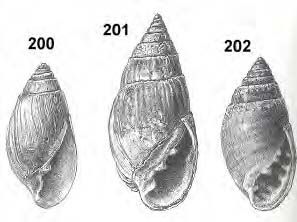|
It all started with an e-mail from the local University. They had heard that I was interested in seashells and one of their research students had found a mass of snails in a salt marsh that they were studying. Could I identify them? Easy, I thought, the only small salt marsh snail occurring in large numbers around here was Hydrobia ulvae so that was probably what it would be. They sent me a sample of the snails. Unfortunately they were only packed in a plastic bag inside an envelope and had been converted from three dimensional snails to two dimensional mush in the post. I arranged to pick up another sample. When I looked at them under the microscope they were obviously not Hydrobia ulvae and I could not trace them in any of my shell guides. I did what I always do when doubtful or baffled by shells – I phoned my old friend and contact in the Conchological Society, Celia Pain. She was about to go off on holiday for three weeks so suggested that I e-mailed her a photo. It is not easy to photograph an 8mm long snail. After several abortive attempts I gave up and tried scanning it in instead. Success! Not brilliant but not bad. I e-mailed it off to Celia. Meantime I thought that I better preserve the snails. How? I had heard that 70% industrial ethanol was the ideal medium but the local chemist said he was not allowed to sell me that. He suggested surgical spirits which is mainly methanol. I diluted it and popped a few snails in. It turned milky and the snails became coated in gunge. I looked at the label. Surgical spirits contains castor oil and other things which seem to precipitate out when you add water. Also it stinks out the whole room when you are working with it. How about Vodka? That is ethyl alcohol – more like 40% than 70% but it might work. You get a very odd look when you ask for a quarter bottle of the cheapest Vodka at the offlicence The Vodka seemed OK. So I put the rest of the snails in and had another look at one. After some time I thought I had managed to identify it. Small salt marsh snail, no operculum and 2 columellar teeth - Leucophyta bidentata ……. except that it was the wrong colour and too large. Quick e-mail to Celia who discussed it with John Llewellyn-Jones and replied “Thanks for your message, you are nearly there, they are the closely related Phytia myosotis.” I looked up Phytia myosotis in the keys. It was the right size and colour but, hang on, P. myosotis has 3 columellar teeth and 2 to 3 teeth inside the outer lip. I examined several more specimens and was even more confused. Although most of them had 2 columellar teeth a few had a vestigial third tooth. None had even a hint of a tooth on the outer lip. I was beginning to contemplate another use for the remaining Vodka. Then I remembered that the Natural History Museum in London used to provide an identification service. I parcelled up a batch of vodka soaked snails and sent them off with a covering note. Two days later I received the following e-mail: “The species that was known as Phytia myosotis, has now been split in to two species Ovatella myosotis (which does not have any teeth on the outer lip) and Ovatella denticulata (which does have teeth on the outer lip). O. myosotis (also known to be generally larger than O. denticulata) is known to show a great deal of variation in the degree of tooth size/development on the columella which again may be where there was some of the confusion when you tried to identify your specimens. That was it! I sank back into my chair relieved. Putting aside the vodka I poured myself a glass of malt whisky to celebrate. My thanks to Celia Pain, John Llewellyn-Jones and Jonathon Ablett (NH Museum) for sorting out this problem. |
200 Leucophytia bidentata
201 Ovatella myosotis
202 Ovatella denticulata
|
The Trials and Tribulations of Amateur Taxonomy
Issue
11
Page
7

 Fig 1 Figure from Freshwater Molluscs of the Netherlands by E. Gittenberger et. al. that helps to demonstrate the variation between these species.
Fig 1 Figure from Freshwater Molluscs of the Netherlands by E. Gittenberger et. al. that helps to demonstrate the variation between these species.